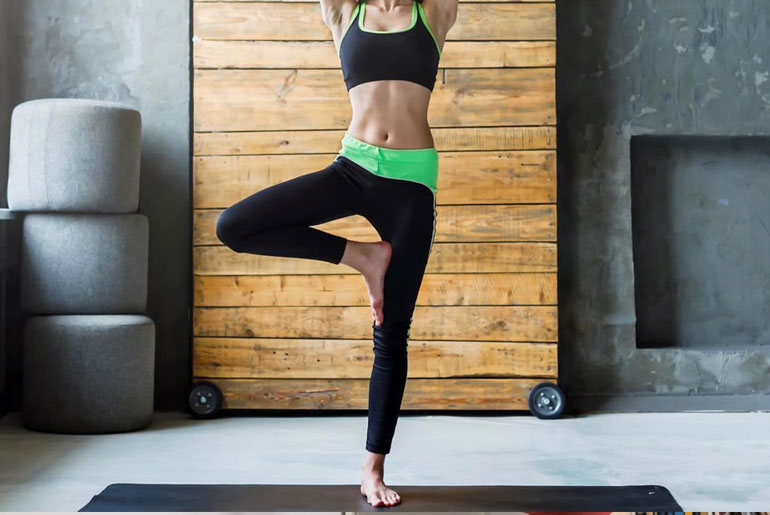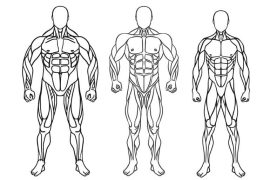“Wall Pilates” is indeed a specific variation of Pilates that involves incorporating a wall into the workout to modify the intensity of each exercise. This approach aims to enhance the benefits of Pilates, particularly in terms of toning and strengthening the core.
Using a wall in Pilates exercises can provide additional support, resistance, or stability, making it a versatile option for individuals practicing at home. The fact that it is considered beginner-friendly and low-impact makes it an attractive choice for a wide range of fitness levels.
The claim that wall Pilates offers similar toning benefits to a reformer Pilates class but without the high cost associated with boutique studios highlights the accessibility of this workout. Reformers are specialized Pilates machines found in many studios, and classes using them can be relatively expensive.
For those interested in trying out Pilates at home or exploring variations like wall Pilates, it’s essential to follow proper techniques and form to maximize the benefits and minimize the risk of injury. As with any fitness routine, it’s advisable to consult with a fitness professional or Pilates instructor, especially when trying new variations or techniques.
Wall Pilates:
Wall Pilates is a variation of traditional Pilates exercises that incorporates the use of a wall to modify the intensity and provide additional support or resistance. In wall Pilates, practitioners perform familiar Pilates movements, such as bridge pose or Pilates 100s, with the assistance of a wall, which mimics the foot bar commonly used in reformer Pilates classes.
The key element of wall Pilates is the use of the wall to add resistance to each movement. By pressing the feet against the wall during different exercises, individuals can create static resistance, simulating some of the benefits of resistance training. This form of resistance training is known as isometric training.
Isometric training involves contracting muscles without changing the length of the muscle or the angle of the adjacent joints. In the context of wall Pilates, this means exerting force against the wall to enhance the strengthening effects of the exercises. The wall essentially becomes a tool for providing a stable surface and added challenge, allowing individuals to exert force at varying levels of their maximal effort.
The use of a wall in Pilates can offer a different dimension to the workout, making it suitable for individuals looking to enhance core strength, stability, and overall muscle tone. As with any exercise program, it’s important to ensure proper form and technique, especially when introducing new variations like wall Pilates. Beginners or those unfamiliar with Pilates may benefit from seeking guidance from a qualified instructor or fitness professional.
The Benefits of Wall Pilates:
Wall Pilates offers a range of potential benefits, combining the principles of traditional Pilates exercises with the unique aspects introduced by the use of a wall. Here are some of the reported benefits of wall Pilates:
- Improved Stability, Balance, and Control: Wall Pilates can enhance stability and balance by incorporating the wall as a support system. The elevation of the feet during exercises may contribute to improved control over movements.
- Increased Circulation: The elevation of the feet throughout the workout in wall Pilates may lead to increased circulation. Improved circulation can have positive effects on overall health, including better digestion and sleep.
- Reduced Muscle Cramps: Practitioners of wall Pilates have reported a reduction in muscle cramps. This could be attributed to the engagement of muscles and improved circulation during the exercises.
- Convenience and Accessibility: Wall Pilates can be practiced in the comfort of one’s home, adding an element of convenience. The use of a wall provides resistance without requiring extra equipment, making it accessible for home workouts.
- Isometric Training: The wall adds resistance to workouts, incorporating isometric training. Isometric training can be an effective way to build strength without putting excessive stress on the joints.
- Abdominal Wall Strengthening: Wall Pilates focuses on core engagement, contributing to the strengthening of the abdominal wall. This can lead to improved core strength and stability.
- Feedback for Proper Form: Using a wall in Pilates exercises serves as a form of feedback, ensuring proper alignment and technique. For example, performing side-lying leg raises against the wall helps maintain correct alignment.
- Alternative Method for Home Workouts: When practicing Pilates at home, the wall serves as an alternative method to maintain proper form, especially when there is no instructor or mirror for visual feedback.
Wall Pilates: A Beginner-friendly Workout:
Wall Pilates is highlighted as a beginner-friendly workout, providing an accessible entry point for individuals new to Pilates. Here are some key features that make wall Pilates suitable for beginners:
- Low Barrier to Entry: Wall Pilates is described as having a low barrier to entry, making it easy for beginners to start. Online workouts are available for free, requiring no specialized equipment and only a small space, making it convenient for those new to fitness.
- Cost-Effective Alternative: For individuals seeking a cost-effective workout, wall Pilates serves as an alternative to in-class Pilates. The ability to practice at home without the need for expensive equipment or studio fees makes it an attractive option.
- Online Accessibility: The availability of wall Pilates workouts online further contributes to its accessibility. Beginners can find instructional videos or guides to follow along, helping them understand and execute the movements correctly.
- No Equipment Needed: One of the advantages of wall Pilates is that it requires little to no equipment. This simplicity makes it more approachable for beginners who may not have access to specialized Pilates equipment.
- Space-Friendly: Wall Pilates doesn’t demand a large workout space, making it suitable for individuals with limited room at home. This feature enhances the practicality of the workout for beginners who may not have a dedicated exercise area.
- Focus on Form and Prevention of Injury: The design of wall Pilates workouts is intentional in catering to beginners. The workouts typically feature slow-paced movements and verbal cues to guide participants through proper form. Emphasizing form helps prevent injuries and allows beginners to build a foundation gradually.
- Gradual Progression: The mention of starting with shorter 5-10 minute workouts until form improves suggests a focus on gradual progression. This approach is beneficial for beginners who may need time to adapt to the movements and build strength.
- Verbal Cues for Guidance: Verbal cues provided in wall Pilates workouts offer guidance for those new to Pilates. Clear instructions help beginners understand the movements and ensure they are performing them correctly.
3 Trendsetting Exercises Wall Pilates:
A. Hip bridge:
The elevated hip bridge is a Pilates exercise that targets the glutes, hamstrings, and lower back. Here are the step-by-step instructions for performing the elevated hip bridge:
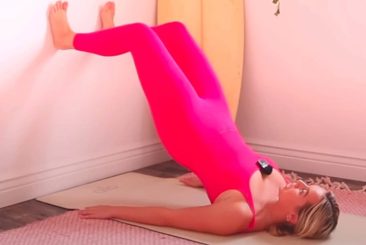
1. Starting Position:
- Lie flat on your back with your face towards the ceiling and your arms resting by your sides on the mat.
- Position yourself close to a wall with your feet about one foot away from it.
- Place your feet hip-width apart on the wall, ensuring that your calves are parallel to the floor, and your thighs are at a slight diagonal.
2. Set Up:
- Tuck your hips under by engaging your abdominal muscles.
- Ensure that your spine is in a neutral position, and your shoulders are relaxed on the mat.
3. Bridge Position:
- Press through your heels and lift your hips off the mat, moving into a bridge position.
- Aim to create a straight line from your shoulders to your knees when in the bridge position.
- Squeeze your glutes at the top of the movement to engage your buttocks.
4. Lowering:
- Slowly lower your hips back down towards the mat, returning to the starting position.
- Maintain control throughout the movement and avoid letting your lower back collapse onto the mat.
5. Repetitions:
- Repeat the entire sequence for 10-15 repetitions.
Tips:
- Focus on the muscles you are engaging, particularly the glutes and hamstrings.
- Keep your core activated throughout the exercise to support your lower back.
- Control the movement both when lifting and lowering your hips.
- Ensure your weight is evenly distributed across both feet.
This exercise helps strengthen the posterior chain, improves hip stability, and engages the core. As with any exercise, listen to your body, and if you experience any discomfort or pain, stop the movement and consult with a fitness professional. If you’re new to exercise or have any existing health concerns, it’s advisable to consult with a healthcare provider or fitness expert before trying new exercises.
B. Wall sit with calf raises:
The wall sit with calf raises is a compound exercise that engages multiple muscle groups, including the quadriceps, hamstrings, glutes, and calves. Here’s a step-by-step guide on how to perform this exercise:
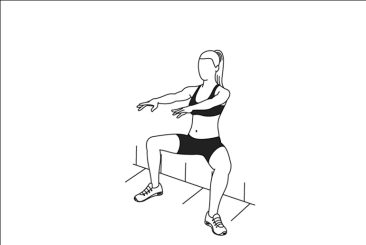
1. Starting Position:
- Stand with your back flat against a wall.
- Ensure that your feet are shoulder-width apart.
2. Wall Sit:
- Slowly walk your feet away from the wall while maintaining contact with your back against the wall.
- Lower your body into a squat position, bending your knees to a 90-degree angle. Your ankles should be directly below your knees.
- Focus on keeping your back against the wall and maintaining a neutral spine.
3. Calf Raises:
- While in the wall sit position, roll through the balls of your feet to lift your heels off the mat.
- Perform a calf raise by lifting your heels as high as comfortable while still staying in the wall sit position.
4. Lower Heels:
- Lower your heels back down to the mat.
5. Repetitions:
- Repeat the calf raises for 15 repetitions while holding the wall sit position.
Tips:
- Engage your core muscles to help stabilize your body during the wall sit.
- Ensure your knees are aligned with your ankles and do not go past your toes to protect your knee joints.
- Control the movement both when lowering into the wall sit and when performing the calf raises.
- Keep your weight evenly distributed between both feet.
This exercise is effective for building lower body strength, particularly in the quadriceps, hamstrings, and calves. It also challenges your stability and endurance. As with any exercise, pay attention to your form, and if you experience any pain or discomfort, stop the exercise and consult with a fitness professional. If you have any existing health concerns or are new to exercise, it’s advisable to consult with a healthcare provider or fitness expert before attempting new exercises.
C. Leg raises:
Leg raises are a classic and effective exercise for targeting the abdominal muscles, particularly the lower abdominals. Here’s a step-by-step guide on how to perform leg raises against a wall:
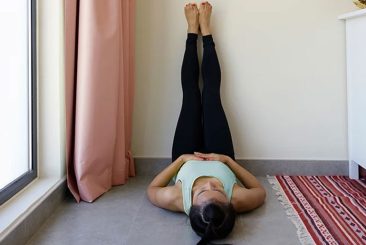
1. Starting Position:
- Lie flat on your back with your face towards the ceiling.
- Position yourself close to a wall with both legs extended vertically, resting against the wall.
- Stretch your arms alongside your body with your palms facing down.
2. Heels Against the Wall:
- Rest both heels against the wall, ensuring that your legs are straight, and your lower back is in contact with the floor.
3. Leg Lifts:
- Lift one leg at a time toward your body, keeping a slight bend in the knee.
- Aim to lift each leg to around a 45-degree angle from the floor. This angle may vary based on your flexibility and strength.
- As you lift one leg, the other leg should remain against the wall.
- Engage your core muscles, especially the lower abdominals, throughout the movement.
4. Alternating Legs:
- Alternate between lifting each leg for a total of 20 repetitions (10 lifts per leg).
Tips:
- Keep your movements controlled and avoid using momentum.
- Focus on using your abdominal muscles to lift your legs rather than relying on your hip flexors.
- Breathe steadily throughout the exercise, exhaling as you lift your leg.
- Ensure that your lower back stays in contact with the floor to avoid unnecessary strain.
Variations:
- If lifting both legs simultaneously is too challenging, you can modify the exercise by lifting one leg at a time.
- For an added challenge, you can increase the number of repetitions or incorporate a small pelvic lift as you raise your legs.
Leg raises are effective for toning the lower abdominal muscles and improving core strength. As with any exercise, it’s important to listen to your body and modify the intensity based on your fitness level. If you experience any pain or discomfort, especially in the lower back, stop the exercise and consult with a fitness professional. If you have any existing health concerns or are new to exercise, consider consulting with a healthcare provider or fitness expert before attempting new exercises.
Disclaimer:
The information contained in this article is for educational and informational purposes only and is not intended as a health advice. We would ask you to consult a qualified professional or medical expert to gain additional knowledge before you choose to consume any product or perform any exercise.

